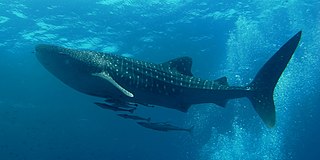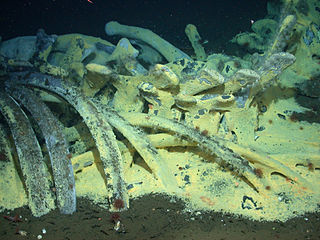Related Research Articles

The great white shark, also known as the white shark, white pointer, or simply great white, is a species of large mackerel shark which can be found in the coastal surface waters of all the major oceans. It is the only known surviving species of its genus Carcharodon. The great white shark is notable for its size, with the largest preserved female specimen measuring 5.83 m (19.1 ft) in length and around 2,000 kg (4,410 lb) in weight at maturity. However, most are smaller; males measure 3.4 to 4.0 m, and females measure 4.6 to 4.9 m on average. According to a 2014 study, the lifespan of great white sharks is estimated to be as long as 70 years or more, well above previous estimates, making it one of the longest lived cartilaginous fishes currently known. According to the same study, male great white sharks take 26 years to reach sexual maturity, while the females take 33 years to be ready to produce offspring. Great white sharks can swim at speeds of 25 km/h (16 mph) for short bursts and to depths of 1,200 m (3,900 ft).

The humpback whale is a species of baleen whale. It is a rorqual and is the only species in the genus Megaptera. Adults range in length from 14–17 m (46–56 ft) and weigh up to 40 metric tons. The humpback has a distinctive body shape, with long pectoral fins and tubercles on its head. It is known for breaching and other distinctive surface behaviors, making it popular with whale watchers. Males produce a complex song typically lasting 4 to 33 minutes.

The tiger shark is a species of ground shark, and the only extant member of the genus Galeocerdo and family Galeocerdonidae. It is a large macropredator, with females capable of attaining a length of over 5 m. Populations are found in many tropical and temperate waters, especially around central Pacific islands. Its name derives from the dark stripes down its body, which resemble a tiger's pattern, but fade as the shark matures.

Sea monsters are beings from folklore believed to dwell in the sea and are often imagined to be of immense size. Marine monsters can take many forms, including sea dragons, sea serpents, or tentacled beasts. They can be slimy and scaly and are often pictured threatening ships or spouting jets of water. The definition of a "monster" is subjective; further, some sea monsters may have been based on scientifically accepted creatures, such as whales and types of giant and colossal squid.

The whale shark is a slow-moving, filter-feeding carpet shark and the largest known extant fish species. The largest confirmed individual had a length of 18.8 m (61.7 ft). The whale shark holds many records for size in the animal kingdom, most notably being by far the most massive living non-cetacean animal. It is the sole member of the genus Rhincodon and the only extant member of the family Rhincodontidae, which belongs to the subclass Elasmobranchii in the class Chondrichthyes. Before 1984 it was classified as Rhiniodon into Rhinodontidae.

The Cuvier's beaked whale, goose-beaked whale, or ziphius is the most widely distributed of all beaked whales in the family Ziphiidae. It is smaller in size than most baleen whales—and indeed the larger toothed cetaceans —yet it is large among the beaked whales and smaller cetaceans, appearing somewhat like a bigger and stockier bottlenose dolphin. Cuvier's beaked whale is pelagic, generally inhabiting waters deeper than 300 m (1,000 ft), though it has been observed closer to shore on occasion. In these offshore waters, Cuvier's beaked whale executes some of the deepest, longest recorded dives among whales, and extant mammals, at 2,992 m (9,816 ft), for 222 minutes. While likely diving to forage and hunt prey, such as cephalopods, and potentially evade predators, the frequency and exact reason for these extraordinary dives is unclear. Despite its deepwater habitat, it is one of the most frequently-spotted beaked whales when surfacing.

The dwarf sperm whale is a sperm whale that inhabits temperate and tropical oceans worldwide, in particular continental shelves and slopes. It was first described by biologist Richard Owen in 1866, based on illustrations by naturalist Sir Walter Elliot. The species was considered to be synonymous with the pygmy sperm whale from 1878 until 1998. The dwarf sperm whale is a small whale, 2 to 2.7 m and 136 to 272 kg, that has a grey coloration, square head, small jaw, and robust body. Its appearance is very similar to the pygmy sperm whale, distinguished mainly by the position of the dorsal fin on the body–nearer the middle in the dwarf sperm whale and nearer the tail in the other.

The basking shark is the second-largest living shark and fish, after the whale shark. It is one of three plankton-eating shark species, along with the whale shark and megamouth shark. Typically, basking sharks reach 7.9 m (26 ft) in length. It is usually greyish-brown, with mottled skin, with the inside of the mouth being white in colour. The caudal fin has a strong lateral keel and a crescent shape. Other common names include bone shark, elephant shark, sailfish, and sunfish. In Orkney, it is called hoe-mother, meaning "the mother of the picked dogfish".

A whale fall occurs when the carcass of a whale has fallen onto the ocean floor, typically at a depth greater than 1,000 m (3,300 ft), putting them in the bathyal or abyssal zones. On the sea floor, these carcasses can create complex localized ecosystems that supply sustenance to deep-sea organisms for decades. In some circumstances, particularly in cases with lower water temperatures, they can be found at much shallower depths, with at least one natural instance recorded at 150 m and multiple experimental instances in the range of 30-382 m. Whale falls were first observed in the late 1970s with the development of deep-sea robotic exploration. Since then, several natural and experimental whale falls have been monitored through the use of observations from submersibles and remotely operated underwater vehicles (ROVs) in order to understand patterns of ecological succession on the deep seafloor.

The great hammerhead is the largest species of hammerhead shark, belonging to the family Sphyrnidae, attaining an average length of 4.6 m (15 ft) and reaching a maximum length of 6.2 m (20 ft). It is found in tropical and warm temperate waters worldwide, inhabiting coastal areas and the continental shelf. The great hammerhead can be distinguished from other hammerheads by the shape of its "hammer", which is wide with an almost straight front margin, and by its tall, sickle-shaped first dorsal fin. A solitary, strong-swimming apex predator, the great hammerhead feeds on a wide variety of prey ranging from crustaceans and cephalopods, to bony fish, to smaller sharks. Observations of this species in the wild suggest that the cephalofoil functions to immobilize stingrays, a favored prey. This species has a viviparous mode of reproduction, bearing litters of up to 50 pups every two years.

Shark cage diving is underwater diving or snorkeling where the observer remains inside a protective cage designed to prevent sharks from making contact with the divers. Shark cage diving is used for scientific observation, underwater cinematography, and as a tourist activity. Sharks may be attracted to the vicinity of the cage by the use of bait, in a procedure known as chumming, which has attracted some controversy as it is claimed to potentially alter the natural behaviour of sharks in the vicinity of swimmers.

The 1992 cageless shark-diving expedition was the world's first recorded intentionally cageless dive with great white sharks, contributing to a change in public opinions about the supposed ferocity of these animals.

Shark tourism is a form of eco-tourism that allows people to dive with sharks in their natural environment. This benefits local shark populations by educating tourists and through funds raised by the shark tourism industry. Communities that previously relied on shark finning to make their livelihoods are able to make a larger profit from diving tours while protecting the local environment. People can get close to the sharks by free- or scuba diving or by entering the water in a protective cage for more aggressive species. Many of these dives are done by private companies and are often baited to ensure shark sightings, a practice which is highly controversial and under review in many areas.

Sodwana Bay is a bay in South Africa on the KwaZulu Natal north coast, between St. Lucia and Lake Sibhayi. It is in the Sodwana Bay National Park, and the Maputaland Marine Reserve, and is a popular recreational diving destination. The term is commonly used to refer to both the marine reserve and the terrestrial park, as well as the geographical bay.

A bait ball, or baitball, occurs when small fish swarm in a tightly packed spherical formation about a common centre. It is a last-ditch defensive measure adopted by small schooling fish when they are threatened by predators. Small schooling fish are eaten by many types of predators, and for this reason they are called bait fish or forage fish.
Representations of the shark are common in popular culture in the Western world, with a range of media generally portraying them of eating machines and threats. In some media, however, comedy is drawn from portrayals of sharks running counter to their popular image, with shark characters being portrayed as unexpectedly friendly or otherwise comical. The lists below give an approximate sample of the many forms of representation of the shark in popular culture.

Ocean Ramsey is a freediver and model. She operates One Ocean Diving, LLC in Hawaii, a company which facilitates dives with marine life. She gained international media attention for free diving with sharks, including great white sharks, to bring attention to sharks and her business. Ramsey is based in Hawaii, and has dived with 47 species of sharks around the world as of 2019.

Valerie May Taylor AM is an Australian conservationist, photographer, and filmmaker, and an inaugural member of the diving hall of fame. With her husband Ron Taylor, she made documentaries about sharks, and filmed sequences for films including Jaws (1975).
Deep Blue is a female great white shark that is estimated to be 6.1 m (20 ft) long or bigger and is now sixty years old. She is believed to be one of the biggest ever recorded in history. The shark was first spotted in Mexico by researcher Mauricio Hoyos Padilla. Deep Blue was featured on the Discovery Channel's Shark Week. The shark was spotted by marine biologists studying tiger sharks near the island of Oahu, Hawaii. Various videos show the shark as calm and non-aggressive around humans and even dolphins.
References
- ↑ "Deep Blue in Hawaii". Shark Diving Xperts. Retrieved 2023-02-18.
- ↑ "A Huge Great White Shark Controversy: Undercurrent 02/2019". Undercurrent.org. 2018-05-22. Retrieved 2023-02-18.
- ↑ Published by Amanda Gardiner on Jun 21, 2019Jun 21, 2019 (2019-06-21). "Why You Should Know Who Deep Blue Is". Cape RADD. Retrieved 2023-02-18.
{{cite web}}: CS1 maint: multiple names: authors list (link) CS1 maint: numeric names: authors list (link) - ↑ "JavaScript is not available". Twitter.com. Retrieved 2023-02-18.
- ↑ "These Divers Swam With A Giant Great White Shark And It's Jaw-Dropping". Buzzfeednews.com. 2019-01-18. Retrieved 2023-02-18.